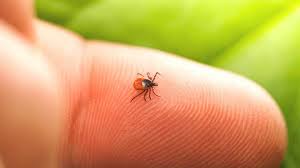
Lyme disease strikes approximates 30,000 people per year. The Mayo Clinic reports that the early symptoms include developing a rash from 3 to 30 days after an infected tick bite; an expanding red area might appear that is sometimes clear in the center, forming a bull’s-eye pattern. The rash expands slowly over days and can spread up to 12 inches across. It’s typically not itchy or painful but might feel warm to the touch. Additional symptoms can include fever, chills, fatigue, body aches, headache, neck stiffness and swollen lymph nodes.

If untreated, new signs and symptoms of Lyme infection might appear in the following weeks to months. The rash may also appear on other areas of your body. Severe joint pain and swelling are especially likely to affect your knees, but the pain can shift from one joint to another. Weeks, months or even years after infection, you might develop inflammation of the membranes surrounding your brain (meningitis), temporary paralysis of one side of your face (Bell’s palsy), numbness or weakness in your limbs and impaired muscle movement.
Antibiotics are the only proven treatment for Lyme disease. After treatment, a small number of people still have some symptoms, such as muscle aches and fatigue. The cause of these continuing symptoms, known as post-Lyme disease syndrome, is unknown and treating with more antibiotics doesn’t help.
According to Adam Breiner, the medical director of The NeuroEdge Brain Performance Center, post-Lyme disease symptoms occur because the bacteria which causes Lyme disease (Borrelia)  likes to hide out in tissues where oxygen and blood flow are lower, such as connective tissues. This bacteria has also been found to create biofilms, which are like a walled-in city. Bacteria can live here in safety until antibiotics are no longer in the body’s system. Then the Borrelia bacteria will reemerge, causing symptoms of Lyme disease to appear once again.

Environmental toxins can assist Lyme disease to stick around. It is important to supplement antibiotics with natural therapies that promote whole-body balance. When the body is overwhelmed with toxins, chemicals, viruses, and bacteria (which is a common state of affairs in the modern world), the organs of detoxification like the liver and lymphatic system become stressed and overtaxed. This makes it much less likely that they’ll be able to fight off Lyme disease and its symptoms.
So how does Far Infrared heat treatment enter into combating the long term effects of Lyme disease?

Far Infrared heat technology has been known to improve immune system functions and help eliminate accumulated toxins in the body. Far infrared waves produce deeply penetrating heat that raises body temperature, inducing an artificial and healthy fever. This promotes the killing of many pathogens, including bacteria, viruses, fungi and parasites. As the body works to combat the “fever,†the body’s immune system is activated and strengthened by increasing production of white blood cells. Combined with the detoxification of harmful toxins and waste products, one’s overall health and resistance to disease are greatly improved. This has the additional benefit of reducing swelling and joint pain.
As a result, far infrared heat therapy helps to detoxify the body in several important ways. Increased blood circulation stimulates the sweat glands, releasing built-up toxins and waste. In addition to causing the body to sweat, far infrared is capable of removing toxins via several other bodily systems.

So, in additional to conventional medical treatment for Lyme disease, this natural approach is also available to help relieve the symptoms that could linger for years after. Charmed FIR Mats® provide you with the means to affordably use this valuable technology in the privacy of your own home. Our mats are easy to use and portable for use away from home too. Find out for yourself the amazing results many thousands of users have already experienced with our mats.





